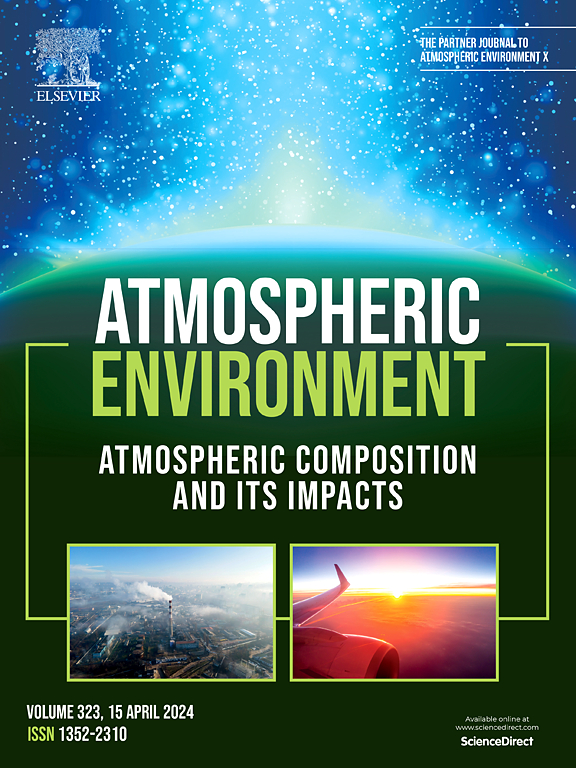The impact of biomass burning emissions in Southeast Asia on black carbon aerosols in southern China
IF 3.7
2区 环境科学与生态学
Q2 ENVIRONMENTAL SCIENCES
引用次数: 0
Abstract
Since 2013, China's air quality has significantly improved due to the reduction of anthropogenic emissions. The influence of long-distance transport of biomass burning emissions in Southeast Asia (BBSEA) on air quality in southern China (SC) would likely continue to increase, especially under the trend of global warming. We quantify the contribution of BBSEA to the surface and high-altitude BC concentrations in SC (two provincial capitals: Guangzhou (GZ), Guangdong, and Kunming (KM), Yunnan) in March–April 2014 and 2019 by using the GEOS-Chem global chemical transport model and its adjoint. For three severe pollution events in SC in 2014, the contributions of BBSEA to daily average BC concentrations in GZ are 0.08–0.19 μg m−3 (2 %–5 %) at the surface and 0.20–0.78 μg m−3 (59 %–73 %) at 700 hPa. In KM, the corresponding contributions are 0.27–0.54 μg m−3 (15 %–33 %) and 0.25–0.45 μg m−3 (28 %–45 %). The transport time of BBSEA to the surface of GZ (KM) is about 3–6 days (1–5 days). The shift in wind fields from southwest to west and stronger wind speeds in April likely shorten the transport time of BBSEA to SC. On March 27, 2019, the relative contributions of BBSEA to the surface BC concentrations increase by 10 % in GZ and 14 % in KM, compared to March 23, 2014. Our study would offer scientific support for understanding BC sources and potential improvement of air quality in SC.

东南亚生物质燃烧排放对中国南方黑碳气溶胶的影响
2013年以来,由于人为排放的减少,中国的空气质量得到了显著改善。特别是在全球气候变暖的大趋势下,东南亚生物质燃烧排放的长途运输对华南地区空气质量的影响可能会持续增加。我们利用GEOS-Chem全球化学输运模型及其伴随模型,量化了2014年3 - 4月和2019年3月至4月SC(两个省会城市:广东广州(GZ)和云南昆明(KM))的BBSEA对地表和高空BC浓度的贡献。在2014年的3次严重污染事件中,BBSEA对GZ日平均BC浓度的贡献分别为地表0.08 ~ 0.19 μ m−3(2% ~ 5%)和700 hPa 0.20 ~ 0.78 μ m−3(59% ~ 73%)。KM的贡献率分别为0.27 ~ 0.54 μ m−3(15% ~ 33%)和0.25 ~ 0.45 μ m−3(28% ~ 45%)。BBSEA到GZ地面的输送时间(KM)约为3 ~ 6天(1 ~ 5天)。4月风场由西南向西转变,风速增大,可能缩短了BBSEA向SC的输送时间。2019年3月27日,BBSEA对GZ地面BC浓度的相对贡献比2014年3月23日增加了10%,KM增加了14%。我们的研究将为了解BC的来源和潜在的改善SC空气质量提供科学支持。
本文章由计算机程序翻译,如有差异,请以英文原文为准。
求助全文
约1分钟内获得全文
求助全文
来源期刊

Atmospheric Environment
环境科学-环境科学
CiteScore
9.40
自引率
8.00%
发文量
458
审稿时长
53 days
期刊介绍:
Atmospheric Environment has an open access mirror journal Atmospheric Environment: X, sharing the same aims and scope, editorial team, submission system and rigorous peer review.
Atmospheric Environment is the international journal for scientists in different disciplines related to atmospheric composition and its impacts. The journal publishes scientific articles with atmospheric relevance of emissions and depositions of gaseous and particulate compounds, chemical processes and physical effects in the atmosphere, as well as impacts of the changing atmospheric composition on human health, air quality, climate change, and ecosystems.
 求助内容:
求助内容: 应助结果提醒方式:
应助结果提醒方式:


